Two compression rings and one oil scraper are installed on the piston.
Compression rings are designed to prevent gases from escaping into the crankcase when they are compressed and expanded
In addition, they serve to transfer heat from the piston to the cylinder.
The oil scraper ring is used to remove excess oil from the working surface of the cylinder and prevent it from entering the combustion chamber.

We unscrew the four head mounting bolts (Fig. 1) and remove the cylinder heads.

With a 13 head, unscrew the nuts of the oil pan, remove the engine pan and pan gasket.
If the crankcase "sticks", you need to knock on it through a wooden gasket.
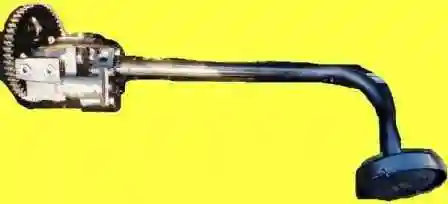
Using keys 13 and 17, remove the oil pump.

Unscrew the nuts of the connecting rod bolts and remove the connecting rod caps (Fig. 4).
Since the lid sits tightly, knock it down with gentle hammer blows.
Remove the connecting rod bearing shell from the cover.

We push the piston into the cylinder so that it comes out of the cylinder, and then take it out along with the connecting rod.
Remove the connecting rod bearing shell from the connecting rod.
Remove the piston with the connecting rod from the cylinder carefully so as not to damage the cylinder mirror.
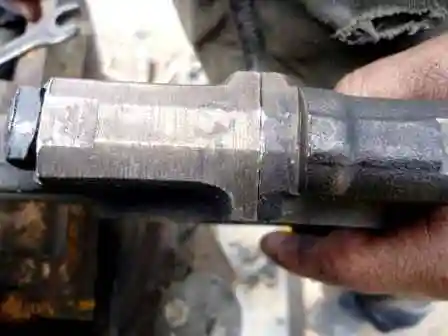
Check the marks on the connecting rod and connecting rod cap.
If the marks are not visible, mark the connecting rod and cap with the cylinder number.

In the same way, we take out the remaining pistons with connecting rods.

Using a plunger expander, remove the piston rings.

Remove the retaining rings from both sides of the piston.
We heat the piston in an oil bath and remove the piston pin from the connecting rod, before noticing the position of the connecting rod relative to the piston.
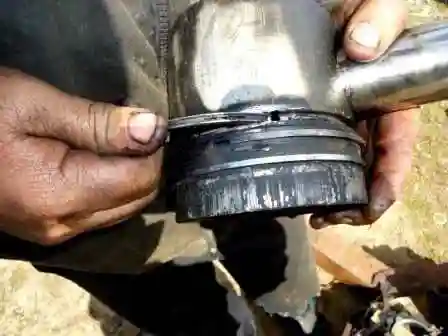
In the same way, remove the remaining pistons from the connecting rods.
After disassembly, wash all parts in gasoline.
Clean the pistons from carbon deposits.
Clean the piston ring grooves with an old piston ring or a broken ring.

To reduce the over-piston clearance when assembling the engine, by selecting the piston version, it is ensured that it protrudes above the sealing end of the sleeve by 0.5-0.7 mm.
The piston variant index (10, 20, 30, 40) is marked on its bottom, as well as a protrusion on the non-working end and sleeves.
The diameter of the piston ring in the free state is larger than the diameter of the cylinder, therefore, when installed, it is tightly pressed against its walls.
In the piston groove, the ring forms a labyrinth seal with a small gap.
Gases, getting into this labyrinth from the space above the piston, reduce their pressure and speed and press the ring against the cylinder wall.
A cut in the ring is called a lock.
In working condition, the ring should always have a gap in the lock so that it does not jam when heated.
The gap value when installing the piston in the cylinder is in the range of 0.4-0.8 mm for compression rings, 0.3-0.7 mm for oil scraper.
In order for the rings to spring freely, they are also installed in the grooves on the piston in height with a small gap.
The end clearance of the upper compression ring is slightly larger than that of the lower one.
Compression rings have a trapezoidal section.
The working surface of the upper compression ring is chrome-plated, has a mirror surface, the lower one is molybdenum, it is matte.
During the movement of the piston, the rings are pressed first to the upper, then to the lower planes of the grooves and thereby create the necessary seal that prevents the breakthrough of gases into the crankcase through the grooves.
At the same time, the compression rings can pump the oil they remove from the cylinder walls into the combustion chamber: when the piston moves down, the oil collects in the gap between the ring and the lower plane of the groove, and when it moves up, the oil is squeezed out into the gap between the ring and the upper plane grooves.
The vacuum in the cylinder during the intake stroke also contributes to this.
With an increase in the end clearance in the ring-piston groove interface, due to the pumping action of the rings, the amount of oil pumped into the combustion chamber increases, as a result, its consumption increases sharply. Therefore, it is necessary to check the end clearance after installing the rings on the piston.
The oil scraper ring is prefabricated; it consists of a cast iron box-section ring with a chrome-plated working surface and a coiled spring expander.
Chrome plating of the rings increases their wear resistance.
The lower groove in the piston for the oil scraper ring has holes around the entire circumference to drain the oil removed by the ring from the surface of the cylinder.
The piston is connected to the connecting rod by a hollow floating pin, the axial movement of which in the piston is limited by two spring retaining rings.
Steel connecting rods, I-section.
The lower end of the connecting rod is detachable.
For an accurate fit of the liners, the lower head of the connecting rod is finished assembled with a cap, as a result of which the caps of the connecting rods are not interchangeable.
The cap and connecting rod are marked with mating marks in the form of three-digit serial numbers.
In addition, the cylinder number is stamped on the connecting rod cap.
Bearings in the upper head of the connecting rod are bimetallic one-piece bushings with a working bronze layer; in the lower head of the connecting rod - removable interchangeable liners.
The cover of the lower head of the connecting rod is fastened with nuts on two bolts pressed into the side projections of the lower head of the connecting rod
Special locking of connecting rod bolts and nuts from self-loosening is not provided.
This is because the connecting rod bolts are automatically prevented from self-loosening due to friction in the threads, provided that the tightening requirements for connecting rod bolt nuts are strictly observed.
Conrod bolts can break due to under-tightening or over-tightening.
The bolts must be tightened to an elongation of 0.25 - 0.27mm.
Installation of rings, pistons and liners in diesel 740 Kamaz
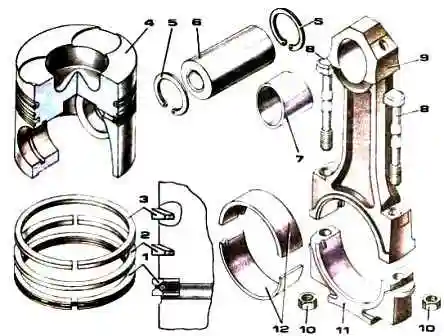
Installing cylinder liners in the block
Before installing the sleeves in the block, CIATIM grease is applied to the chamfers.
Cylinder liners are inserted carefully by hand, avoiding cutting off the sealing rings protruding from the grooves.
The piston with pin and connecting rod is assembled after heating the piston to a temperature of 80÷100˚ C.
The holes in the connecting rod under the pin and the pin itself are pre-lubricated with diesel oil.
The finger is set with the force of the thumb. It is not allowed to press the finger with a tool.

The grooves on the piston and the grooves for the mustaches of the liners on the connecting rod should be located in one direction (Fig. 16).
Piston pins are secured with circlips.
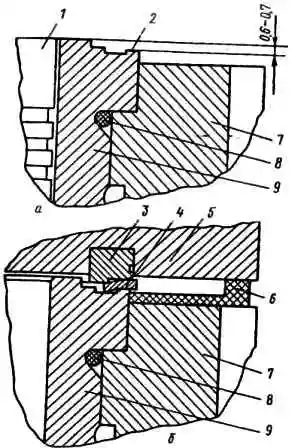
The piston is selected according to the distance from the generatrix of the connecting rod journal of the crankshaft in its upper position to the thrust shoulder of the liner in such a way that the output of the piston bottom above the thrust shoulder of the cylinder liner is within 0.6 ÷ 0.7 mm, Figure 17.

The method of measuring the distance from the generatrix of the connecting rod journal of the crankshaft in its upper position to the sealing shoulder of the cylinder liner is shown in Figure 18.
Data for selecting a piston according to the sleeve in table 1.
| Piston index | Distance from connecting rod journal to cylinder liner thrust shoulder, mm | Distance from the connector plane to the center of the ring, mm |
|---|---|---|
| 10 | 260.12-260.24 | 75.67-75.71 |
| 20 | 260.24-260.35 | 75.78-75.82 |
| 30 | 260.35-260.46 | 75.89-75.93 |
| 40 | 260.46-260.57 | 76.00-76.04 |
After the pistons have been selected at the factory, the indexes of piston variants 10, 20, 30, 40 are applied on the piston crown and on the non-working protrusion of the sleeve end.
When assembling, you need to select pistons and cylinders with the same index.
When installing the piston into the sleeve, the undercuts for the valves on the piston must be installed closer to the axis of the crankshaft.
The total clearance between the ends of the lower heads of the connecting rods and the crankshaft journals (axial play) must be at least 0.15 mm.
Piston rings must have thermal gaps before being installed on the piston. The piston ring clearance is measured in a caliber with a diameter of 120 + 0.03 mm.

Gap dimensions are shown in table 2
| Settings | Gap after restore | Adjustment |
|---|---|---|
| Compression Ring Lock | 0.4-0.6 | 0.8 |
| Lock in oil scraper piston rings | 0.30-0.45 | 0.7 |
| Upper Compression Ring End Gap | 0,12-017 | 0.22 |
| Lower Compression Ring End Gap | 0.09-0.14 | 0.19 |
| Oil ring end gap | 0.07-0.011 | 0.2 |
| Piston-sleeve clearance (when measured at a distance of 0.119-1.162 mm from piston crown | 0.12-0.16 | 0.22 |
Install the piston rings using a plunger expander (if any).
The oil scraper ring is inserted into the piston groove and the ring is put on so that the expander joint is at an angle of 180˚ to the ring lock.
After that, install the compression rings.
Insert the molybdenum plated ring first, then the chrome plated ring.
The locks of adjacent rings move apart.





